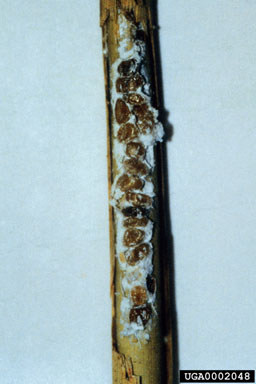Description
Taxonomy
| Kingdom | Phylum | Class | Order | Family | Genus |
|---|---|---|---|---|---|
| Animalia | Hexapoda | Insecta | Homoptera | Pseudococcidae | Chaetococcus |
Synonyms
Invasion History
Chesapeake Bay Status
| First Record | Population | Range | Introduction | Residency | Source Region | Native Region | Vectors |
|---|---|---|---|---|---|---|---|
| 2000 | Established | Unknown | Introduced | Regular Resident | Europe | Eurasia | Shipping(unspecified), Ornamental(Aquatic Plant); Agriculture(Packing Material) |
History of Spread
Chaetococcus phragmitis, a legless reed mealybug, is native to Eurasia, in Western and Central Asia (Blossey and Weber 2000). It is found only on reeds of the genera Phragmites and Arundo. This insect was found to be widespread and abundant in the northeastern US, from MD, DE, NJ, and NY, before 1996 (Kosztarab 1996). It was collected in Chesapeake Bay tidal Phragmites australis marshes near Tappahannock VA on the Rappahannock River, and in Dameron Marsh, Northumberland County VA in 2000 (Blossey and Weber 2000).
References- Blossey and Weber 2000; Kosztarab 1996
Invasion Comments
Ecology
Environmental Tolerances
| For Survival | For Reproduction | |||
|---|---|---|---|---|
| Minimum | Maximum | Minimum | Maximum | |
| Temperature (ºC) | ||||
| Salinity (‰) | 0.0 | 0.0 | ||
| Oxygen | ||||
| pH | ||||
| Salinity Range | fresh-poly |
Age and Growth
| Male | Female | |
|---|---|---|
| Minimum Adult Size (mm) | 1.9 | |
| Typical Adult Size (mm) | ||
| Maximum Adult Size (mm) | 7.2 | |
| Maximum Longevity (yrs) | ||
| Typical Longevity (yrs |
Reproduction
| Start | Peak | End | |
|---|---|---|---|
| Reproductive Season | |||
| Typical Number of Young Per Reproductive Event |
|||
| Sexuality Mode(s) | |||
| Mode(s) of Asexual Reproduction |
|||
| Fertilization Type(s) | |||
| More than One Reproduction Event per Year |
|||
| Reproductive Startegy | |||
| Egg/Seed Form |
Impacts
Economic Impacts in Chesapeake Bay
The effects of insect herbivores of Phragmites australis (Common Reed), including Chaetococcus phragmitis, have not been studied in Chesapeake Bay or elsewhere in North America. Potentially, these introduced insects could affect the aggressive invasion of P. australis in Chesapeake Bay wetlands. Studies of these insects are needed in order to determine whether P. australis control programs need to be redesigned to preserve and enhance the effect of introduced herbivore populations (Blossey and Weber 2000).
References- Blossey and Weber 2000)
Economic Impacts Outside of Chesapeake Bay
Insect herbivores of Phragmites australis (Common Reed), including Chaetococcus phragmitis, are considered pests of reed-beds in Europe. However, the effects of these insects on the population dynamics and abundance of P. australis has not been studied in Europe or North America. Potentially, these introduced insects could affect the aggressive invasion of P. australis in eastern North American wetlands (Blossey and Weber 2000).
References- Blossey and Weber 2000
Ecological Impacts on Chesapeake Native Species
Impacts of the mealybug Chaetococcus phragmitis on native Phragmites australis (Common Reed) populations are unknown. This insect appears to be an abundant food source for native birds (Blossey and Weber 2000).
References- Blossey and Weber 2000
Ecological Impacts on Other Chesapeake Non-Native Species
Insect herbivores of Phragmites australis (Common Reed), including Chaetococcus phragmitis, are considered pests of reed-beds in Europe. However, the effects of these insects on the population dynamics and abundance of P. australis has not been studied in Europe or North America. Potentially, these introduced insects could affect the aggressive invasion of P. australis in eastern North American wetlands (Blossey and Weber 2000). Chaetococcus phragmitis also attacks Arundo donax (Giant Reed), known from nontidal habitats in the Chesapeake bay watershed (Blossey and Weber 2000).
References- Blossey and Weber 2000
References
Blossey, Bernd; Weber, Joseph T. (2000) First Virginia records of four European insect herbivores of Phragmites australis., Banisteria 16: 29-35Haslam, S. M. (1972) Biological flora of the British Isles List Br. Vasc. Pl. (1958) No. 665, . 1. Phragmites communis, Journal of Ecology 60: 585-610
Kosztarab, Michael (1996) Scale insects of northeastern North America, In: (Eds.) . , Martinsville, VA. Pp.
Marks, Marianne; Lapin, Beth; Randall, John (1994) Phragmites australis (P. communis): Threats, management, and monitoring, Natural Areas Journal 14: 285-294
